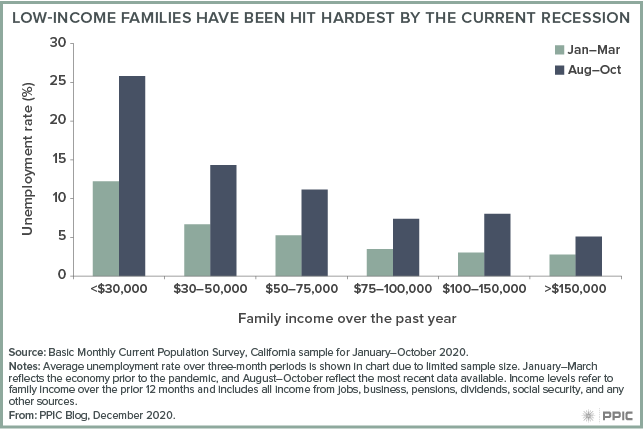This post is part of a blog series on income inequality and economic recovery. You can view all these posts on our poverty and inequality page.
The COVID-19 pandemic upended California’s economy and threatens to worsen racial, gender, and regional disparities in income. Our new report examines the state policy levers that could promote an equitable recovery and address the needs of the most affected workers and regions. While California policymakers have many tools at their disposal, federal policy choices will have an outsized impact on California’s families, especially in the short term.
Nearly all recessions and recoveries over the past 40 years have widened income inequality in California, as earnings for low-income families dropped most precipitously and took longest to recover. At the worst point in the Great Recession, for example, incomes for the highest earners fell 6% compared to prerecession levels, while incomes for the lowest-income families dropped 20% (and to a much lower level—$18,500 for a family of four, in 2019 dollars).
The current crisis is following a similar—or worse—trajectory. Unemployment has spiked the most among lower-income families due to the disproportionate effects on in-person service jobs. As of this fall, one-quarter of workers in families with annual income less than $30,000 were unemployed, as were 11%–14% of workers in families with income between $30,000 and $75,000. Left unchecked, these trends threaten to dramatically increase inequality.

Creating conditions for businesses to grow and jobs to recover is paramount—but the pandemic constrains what can be done. Until in-person economic activity fully resumes, targeting policy interventions to the hardest-hit workers and businesses would go a long way to supporting their economic well-being and ensuring that the state can rebound once COVID-19 abates.
The federal government has much greater capacity to financially support businesses than the state does, as the state cannot operate at a deficit and is limited by current revenues. The federal Paycheck Protection Program (PPP) provided some support to California businesses early on in the pandemic. However, evidence suggests that the program funded many larger businesses that already had access to capital. State efforts have the potential to be better targeted but will also be more fiscally limited. Leveraging funds through public-private partnerships and Community Development Financial Institutions could prove fruitful, if conditions are set to ensure that funds are directed to businesses with the greatest need and with limited access to traditional sources of financing.
The federal government also plays a vital role in supporting Californians who have lost jobs. Standard unemployment insurance benefits are financed through employer contributions, but funding from the federal CARES Act made weekly benefits more generous, extended the length of benefits, and reached many workers who would otherwise not qualify. In total, over $110 billion in benefits were provided to California families between March and November. But even the portion covered by federal dollars far exceeds what the state would be able to fund.
For many low-income families, unemployment benefits work together with safety net programs like CalFresh to meet basic needs. High rates of food scarcity and missed housing payments indicate that significant gaps in family resources remain. State policymakers should consider how to address these gaps—for example, by ensuring that programs reach as many eligible Californians as possible and by identifying and finding other ways to assist those who are ineligible (such as undocumented immigrants). However, the federal government’s support for such programs is essential.
Congressional action—or inaction—this month will be extremely consequential. Unemployment benefits for roughly 750,000 Californians are set to expire at the end of the month, and many businesses will likely suffer from the resurgence of COVID-19 and a second round of stay-at-home orders. As new leaders take office in Washington DC this winter, their decisions will be crucial to fostering a swift and equitable economic recovery.
This week, our blog is focusing on income inequality and economic recovery. Tomorrow, we examine Californians’ views on policy proposals to support recovery.







